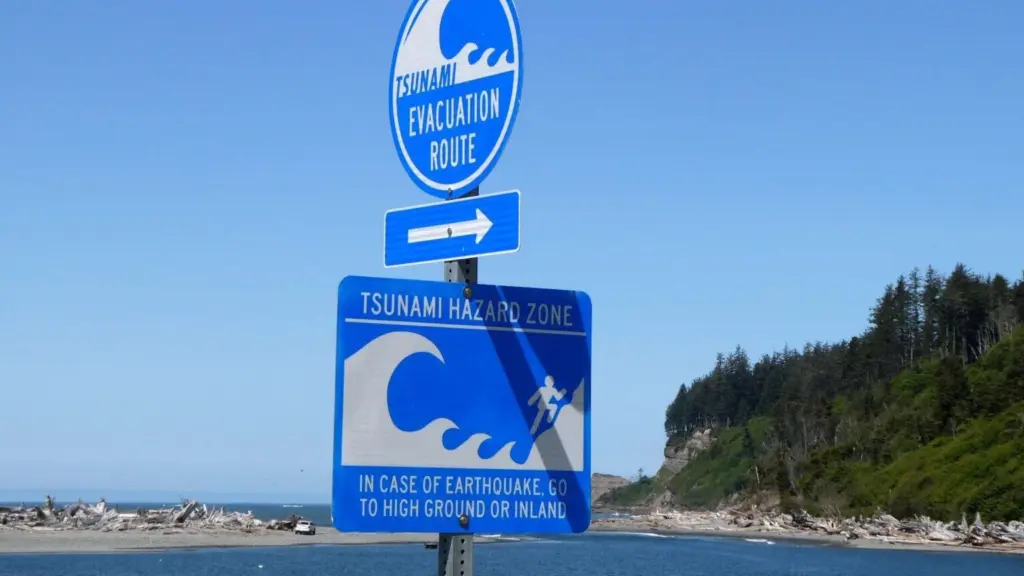OCEAN SHORES, WA – Teachers and staff in low-lying schools along the Pacific Northwest coast face an unusual extra responsibility alongside educators’ usual duties: can they herd the entire student body to higher ground on foot in 20 minutes or less to escape a tsunami?
It’s a daunting challenge with the highest possible stakes should an offshore earthquake unleash a wall of incoming seawater. The last megathrust earthquake to hit the region was in 1700, and the Northwest is now in the window for the next magnitude 9.0+ Cascadia fault quake and tsunami.
“It’s something that’s always on your mind. You try not to let this take over,” said North Beach School District Superintendent Richard Zimmerman.
The Washington Legislature allocated $151.5 million in the recently passed state construction budget to relocate three coastal schools out of the tsunami zone and build a refuge tower at a fourth. Zimmerman’s district is one of the beneficiaries, along with the Taholah and Cape Flattery school districts.
“We’re anxious to get this done because the lives of our students, staff and community might very well depend on it,” Zimmerman said in an interview from Ocean Shores.
The Legislature giveth and taketh away
In 2022, the Washington Legislature got serious about the hundreds of older, unreinforced public schools at risk of collapse in a major earthquake. Lawmakers allocated $100 million to a revamped School Seismic Safety Grant Program overseen by the Office of the Superintendent of Public Instruction. In 2023, the Legislature chipped in another $40 million.
But now comes an unexpected twist. This spring, the Legislature took back more than half of that initial sum — $80 million — because it was unspent. OSPI Director of School Facilities Randy Newman said money was left in the bank toward the end of the budget cycle because many of the prioritized seismic retrofits and school relocations were still in the design phase. The state schools superintendent asked to carry over the unspent balance into the next budget along with the new allocation, but lawmakers chose not to.
“The reality of trying to find the right locations, negotiating the contracts, doing the engineering has taken more time,” noted state Rep. Steve Tharinger, D-Port Townsend, the chair of the House Capital Budget Committee. “It’s taken us a while to build momentum.”
Tharinger said the Legislature’s budget writers decided to be more prescriptive in the newly signed state budget by steering specific sums to projects ready to go in the most vulnerable coastal school districts. Hence, the green light to break ground in Ocean Shores, Taholah and Neah Bay.
Overall, the seismic safety program was renewed at a lower level than the state superintendent asked for in light of many other competing priorities for state construction dollars.
“It’s pretty exciting to have avoided a tragedy and to be able to start building schools in safer places,” Tharinger said.
From his perch in the state superintendent’s office, Newman wishes the Legislature had funded additional school seismic projects in the new budget. Since 2021, he’s seen state-funded earthquake retrofits through to completion in Centralia, South Bend, Boistfort and Marysville — with Cosmopolis Elementary on deck to receive seismic strengthening this summer.
“We were happy with the funding level we received from the Legislature,” to now lift the highest priority schools out of the tsunami zone, Newman said in an interview last week.
Placed on standby pending future funding were multiple projects in Hoquiam, Aberdeen and the Long Beach peninsula, including seismic retrofits and elementary school consolidations and relocations. Also on the state’s future priority list is a rooftop tsunami refuge atop a seismically-strengthened North Beach Junior/Senior High School in Ocean Shores.
Washington state has long lagged behind neighboring West Coast states and provinces in addressing earthquake risk in school buildings. The Oregon Legislature, way back in 2005, created a school seismic retrofit grant program on the scale now underway from Olympia. The provincial government of British Columbia started a seismic mitigation program for schools in 2004 and has shelled out more than $1.9 billion since then.
Moving to higher ground… or climbing tower stairs
The relocation of the Taholah K-12 public school is part of a larger, years-long process led by the Quinault Nation to move much of the lower village of Taholah about three-quarters of a mile uphill, out of danger from increasingly common floods, storm surges and a future tsunami. The new school will eventually be surrounded by neighborhoods, parks and ballfields to be built on freshly-cleared forestland.
Taholah Superintendent Herman Lartigue Jr. said he hopes to welcome roughly 200 students to their new quake-ready school in 2027. He said the use of cedar planking on the outside of the school and exposed cedar beams and columns inside — as well as installations of tribal art — would give the building a distinctive appearance.
“This building is going to be indicative of the culture. It’s great,” Lartigue said.
The Cape Flattery School District is making a parallel push to incorporate tribal culture in the new Neah Bay K-12 campus, which will replace an elementary school and secondary school at sea level on the Makah reservation. The groundbreaking is tentatively scheduled for mid-July, with move-in anticipated in mid-2027.
The Makah Nation donated a long-term lease on a hillside parcel about one mile inland from Neah Bay to build the new school with a capacity for about 600 students. District Superintendent Michelle Parkin said she harbored a lot of concern last winter upon reading about the budget shortfalls the 2025 Legislature had to grapple with.
“It’s such a relief,” the school relocation funding came through, Parkin said. “Our children are going to be safe.”
Some unusual features of the new Neah Bay school she mentioned include a fish hatchery on campus, carving and canoe making areas in the shop class space, and outdoor fire pits where students can learn to kipper salmon.
In Grays Harbor County, the $8.2 million budgeted by the Legislature to relocate Pacific Beach Elementary covers land acquisition and conceptual design, but isn’t enough to construct a new school on higher ground. The existing school, which enrolls around 100 students, was built within earshot of the Pacific surf in 1956, long before modern seismic codes existed.
Moving the North Beach district’s other primary school out of harm’s way is virtually impossible because there is no suitable high ground nearby on the long and flat Ocean Shores peninsula. The solution the Legislature blessed with $8.2 million is to build a tsunami evacuation tower next to Ocean Shores Elementary.
This robust steel tower will have a platform on top with a minimum capacity of 300 people to host the entire student body and staff. Modeling done for the city of Ocean Shores in connection with another tsunami tower proposal said the refuge platform should be about 50 feet high to be comfortably above the surging waves.
Earthquake risk mitigation can also be done with local funding, which is how larger and wealthier Washington school districts have replaced or modernized the majority of their buildings to withstand strong shaking. But small and rural districts with limited tax bases and tax-averse voters usually have trouble with that approach.
Waiting years in line for state grant funding for seismic upgrades is a gamble, but there’s a financial incentive for districts: taxpayers statewide foot the bill for at least two-thirds — if not close to 100% — of the school reconstruction costs.
“We know that districts have struggled to pass local bonds and levies to modernize their school facilities,” Newman said. “It’s a big lift to address all the seismic needs of aging school buildings.”
Washington State Standard is part of States Newsroom, a nonprofit news network supported by grants and a coalition of donors as a 501c(3) public charity. Washington State Standard maintains editorial independence. Contact Editor Bill Lucia for questions: info@washingtonstatestandard.com.





